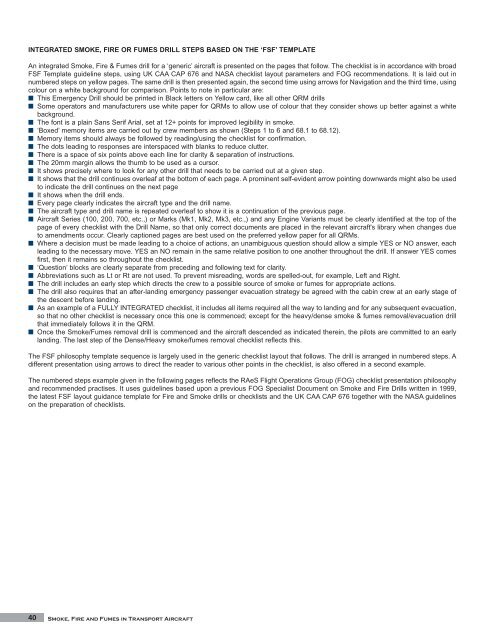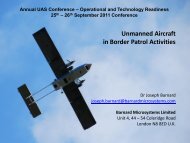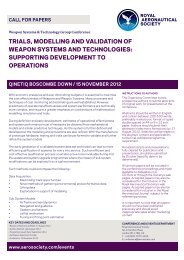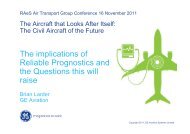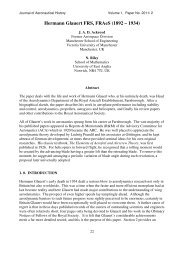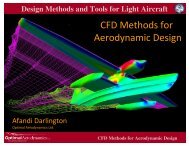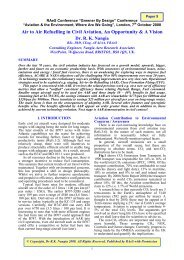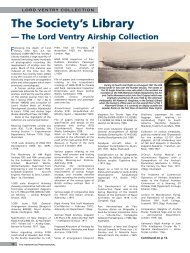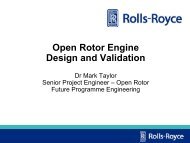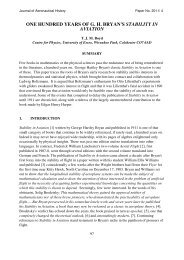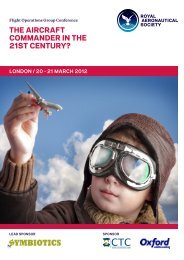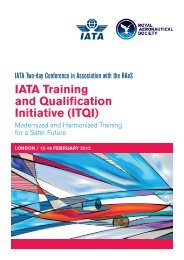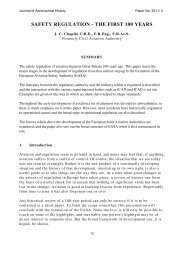Smoke, Fire and Fumes in Transport Aircraft - Royal Aeronautical ...
Smoke, Fire and Fumes in Transport Aircraft - Royal Aeronautical ...
Smoke, Fire and Fumes in Transport Aircraft - Royal Aeronautical ...
Create successful ePaper yourself
Turn your PDF publications into a flip-book with our unique Google optimized e-Paper software.
INTEGRATED SMOKE, FIRE OR FUMES DRILL STEPS BASED ON THE ‘FSF’ TEMPLATE<br />
An <strong>in</strong>tegrated <strong>Smoke</strong>, <strong>Fire</strong> & <strong>Fumes</strong> drill for a ‘generic’ aircraft is presented on the pages that follow. The checklist is <strong>in</strong> accordance with broad<br />
FSF Template guidel<strong>in</strong>e steps, us<strong>in</strong>g UK CAA CAP 676 <strong>and</strong> NASA checklist layout parameters <strong>and</strong> FOG recommendations. It is laid out <strong>in</strong><br />
numbered steps on yellow pages. The same drill is then presented aga<strong>in</strong>, the second time us<strong>in</strong>g arrows for Navigation <strong>and</strong> the third time, us<strong>in</strong>g<br />
colour on a white background for comparison. Po<strong>in</strong>ts to note <strong>in</strong> particular are:<br />
■ This Emergency Drill should be pr<strong>in</strong>ted <strong>in</strong> Black letters on Yellow card, like all other QRM drills<br />
■ Some operators <strong>and</strong> manufacturers use white paper for QRMs to allow use of colour that they consider shows up better aga<strong>in</strong>st a white<br />
background.<br />
■ The font is a pla<strong>in</strong> Sans Serif Arial, set at 12+ po<strong>in</strong>ts for improved legibility <strong>in</strong> smoke.<br />
■ ‘Boxed’ memory items are carried out by crew members as shown (Steps 1 to 6 <strong>and</strong> 68.1 to 68.12).<br />
■ Memory items should always be followed by read<strong>in</strong>g/us<strong>in</strong>g the checklist for confirmation.<br />
■ The dots lead<strong>in</strong>g to responses are <strong>in</strong>terspaced with blanks to reduce clutter.<br />
■ There is a space of six po<strong>in</strong>ts above each l<strong>in</strong>e for clarity & separation of <strong>in</strong>structions.<br />
■ The 20mm marg<strong>in</strong> allows the thumb to be used as a cursor.<br />
■ It shows precisely where to look for any other drill that needs to be carried out at a given step.<br />
■ It shows that the drill cont<strong>in</strong>ues overleaf at the bottom of each page. A prom<strong>in</strong>ent self-evident arrow po<strong>in</strong>t<strong>in</strong>g downwards might also be used<br />
to <strong>in</strong>dicate the drill cont<strong>in</strong>ues on the next page<br />
■ It shows when the drill ends.<br />
■ Every page clearly <strong>in</strong>dicates the aircraft type <strong>and</strong> the drill name.<br />
■ The aircraft type <strong>and</strong> drill name is repeated overleaf to show it is a cont<strong>in</strong>uation of the previous page.<br />
■ <strong>Aircraft</strong> Series (100, 200, 700, etc.,) or Marks (Mk1, Mk2, Mk3, etc.,) <strong>and</strong> any Eng<strong>in</strong>e Variants must be clearly identified at the top of the<br />
page of every checklist with the Drill Name, so that only correct documents are placed <strong>in</strong> the relevant aircraft's library when changes due<br />
to amendments occur. Clearly captioned pages are best used on the preferred yellow paper for all QRMs.<br />
■ Where a decision must be made lead<strong>in</strong>g to a choice of actions, an unambiguous question should allow a simple YES or NO answer, each<br />
lead<strong>in</strong>g to the necessary move. YES an NO rema<strong>in</strong> <strong>in</strong> the same relative position to one another throughout the drill. If answer YES comes<br />
first, then it rema<strong>in</strong>s so throughout the checklist.<br />
■ ‘Question’ blocks are clearly separate from preced<strong>in</strong>g <strong>and</strong> follow<strong>in</strong>g text for clarity.<br />
■ Abbreviations such as Lt or Rt are not used. To prevent misread<strong>in</strong>g, words are spelled-out, for example, Left <strong>and</strong> Right.<br />
■ The drill <strong>in</strong>cludes an early step which directs the crew to a possible source of smoke or fumes for appropriate actions.<br />
■ The drill also requires that an after-l<strong>and</strong><strong>in</strong>g emergency passenger evacuation strategy be agreed with the cab<strong>in</strong> crew at an early stage of<br />
the descent before l<strong>and</strong><strong>in</strong>g.<br />
■ As an example of a FULLY INTEGRATED checklist, it <strong>in</strong>cludes all items required all the way to l<strong>and</strong><strong>in</strong>g <strong>and</strong> for any subsequent evacuation,<br />
so that no other checklist is necessary once this one is commenced; except for the heavy/dense smoke & fumes removal/evacuation drill<br />
that immediately follows it <strong>in</strong> the QRM.<br />
■ Once the <strong>Smoke</strong>/<strong>Fumes</strong> removal drill is commenced <strong>and</strong> the aircraft descended as <strong>in</strong>dicated there<strong>in</strong>, the pilots are committed to an early<br />
l<strong>and</strong><strong>in</strong>g. The last step of the Dense/Heavy smoke/fumes removal checklist reflects this.<br />
The FSF philosophy template sequence is largely used <strong>in</strong> the generic checklist layout that follows. The drill is arranged <strong>in</strong> numbered steps. A<br />
different presentation us<strong>in</strong>g arrows to direct the reader to various other po<strong>in</strong>ts <strong>in</strong> the checklist, is also offered <strong>in</strong> a second example.<br />
The numbered steps example given <strong>in</strong> the follow<strong>in</strong>g pages reflects the RAeS Flight Operations Group (FOG) checklist presentation philosophy<br />
<strong>and</strong> recommended practises. It uses guidel<strong>in</strong>es based upon a previous FOG Specialist Document on <strong>Smoke</strong> <strong>and</strong> <strong>Fire</strong> Drills written <strong>in</strong> 1999,<br />
the latest FSF layout guidance template for <strong>Fire</strong> <strong>and</strong> <strong>Smoke</strong> drills or checklists <strong>and</strong> the UK CAA CAP 676 together with the NASA guidel<strong>in</strong>es<br />
on the preparation of checklists.<br />
40<br />
<strong>Smoke</strong>, <strong>Fire</strong> <strong>and</strong> <strong>Fumes</strong> <strong>in</strong> <strong>Transport</strong> <strong>Aircraft</strong>


